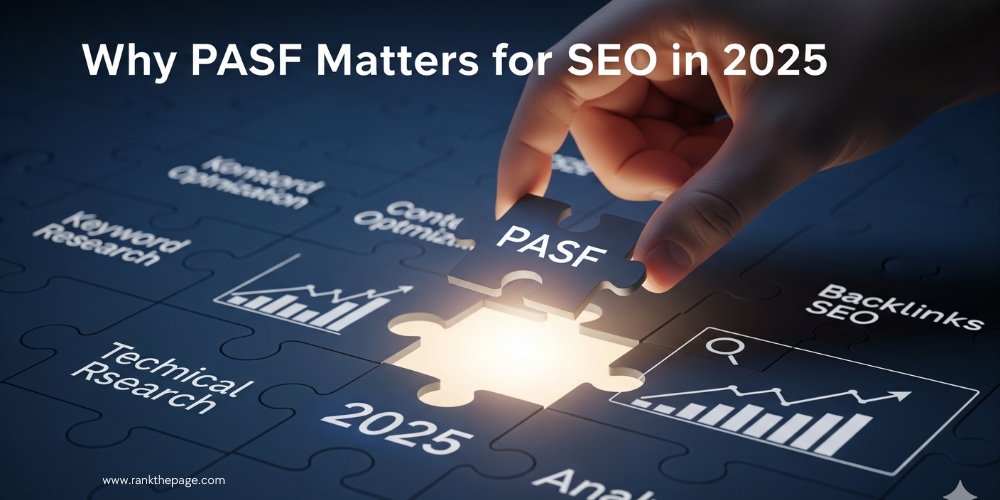Google has transformed search over the last couple of years, and so has the process of Google guiding users through results. One feature that quietly shapes the search journey is that people also search for. You’ve probably noticed it, those related queries that appear after you click a result and return to the SERP. What looks like a small suggestion box is actually a powerful window into user behaviour and search intent.
In 2025, PASF is more than just a convenience for searchers. It is a gold rush for those SEOs and marketers that understand how to utilise it. Learning how to create a clever PASF SEO plan can open up concealed opportunities for keywords, reinforce topical authority, and put your material on the long term radar, whether you’re working in house or with a professional seo agency.
This guide is a step by step walkthrough of everything you should know about PASF in 2025, its functionality, its importance, the current trends, and practical measures to ensure that you are ahead of your competition.
What Is People also Search in Google?
When you click on a result of a search and quickly go back to the SERP, a small box containing related queries will appear on Google. This is the PASF feature. It is how Google is predicting what you may be searching, and narrowing down the search experience.
In 2025, this feature has evolved. PASF is gradually becoming a more important part of search intent optimization, with Google now pairing it more closely with other SERP features, like People Also Ask (PAA) and related searches.
Why PASF Matters for SEO in 2025

Ignoring PASF means missing out on potential traffic. Let’s know the importance of PASF:
- Better relevance indicators: PASF offers information about the specific search query that users make once they visit your site.
- Content discovery: Being featured in PASF queries improves your reach beyond traditional rankings.
- Search intent alignment: Your content is more comprehensive in answering the needs of users because it tackles PASF queries.
In simple terms, by optimising for those who are also searching, you increase your opportunity to remain visible even when they may not necessarily click on your page. That’s why many businesses turn to a trusted seo agency to ensure they don’t overlook these intent driven opportunities.
PASF vs. People Also Ask – What’s the Difference?
Many confuse PASF with PAA. While both provide related queries, the mechanics are different:
- People Also Search For: Appears after clicking and bouncing from a result.
- People Also Ask: Appears directly in SERPs as expandable question boxes.
For SEOs, both are opportunities. But PASF reveals second step user behaviour, making it especially powerful for keyword discovery.
How Google’s PASF Algorithm Works
The People Also Search For (PASF) feature isn’t random, it’s powered by an algorithm that evaluates multiple factors to surface the most relevant queries. Here’s what typically influences the results you see:
1. Primary Search Query
The starting point is always the main search. Google searches the related questions that intuitively relate to the original query by the user.
2. Location of the Searcher
Where a person is searching from plays a role. Local context often shifts the type of related searches that appear.
3. Device Type
The outcome can be slightly different when searching on mobile, desktop, or tablet because user behaviour varies among different devices.
4. Search History
Google considers what the individual has searched for previously to personalise and refine the suggested related queries.
5. Browsing Behavior
Beyond searches, broader browsing patterns help the algorithm understand what may be helpful in context to the primary query.
6. SERP Content
Even the structure of the search results page itself (titles, snippets, and metadata) is a factor in determining which related searches are triggered.
7. Real Time Updates
PASF isn’t static. It is constantly updated to reflect the latest trends, user behaviour, and emerging queries.
How to Build a Winning PASF SEO Strategy
A strong strategy isn’t about stuffing keywords. It’s about anticipating and answering searchers’ needs. Here’s how:
1. Identify PASF Keywords
Utilise tools like SEMrush, Ahrefs, or conduct manual SERP testing to identify common PASF queries. These often overlap with long tail keywords.
2. Create Comprehensive Content
Structure your articles to cover core keywords, PASF queries, and related questions. The more user intent you satisfy, the more likely Google will surface your content. Well planned resources, such as the top content marketing strategies to demonstrate how covering multiple angles can boost engagement and visibility.
3. Optimise On Page SEO
Include PASF terms in subheadings, FAQs, and body text naturally. Keep density low but impactful.
4. Monitor Search Behaviour
Track bounce rates and time on page. High engagement signals to Google that your content satisfies PASF related intent.
5. Leverage Internal Linking
Link to related blog posts that answer PASF queries. This strengthens topical authority.
Latest Trends in PASF for 2025
In 2025, PASF will adapt using advanced personalisation based on how people search and interact with results.
- Voice Search Integration: PASF results now align closely with conversational queries from smart devices.
- Local SEO Influence: PASF often displays location based suggestions, which are crucial for local businesses.
- Content Depth Preference: Google favours long form, comprehensive guides that address multiple PASF queries at once.
If you adapt your PASF SEO strategy to these shifts, you’ll stay ahead of competitors.
Practical Examples of PASF in Action
Let’s say a user searches for “best SEO tools 2025.” After clicking one result and bouncing back, PASF might suggest:
- Affordable SEO platforms
- Automated keyword research tools
- How to choose an SEO tool for a small business
By incorporating these into your content, you capture additional intent paths and increase your SERP presence.
Benefits of Optimising for PASF
- Higher visibility across multiple SERP features.
- Reduced bounce rates by aligning better with user expectations.
- Authority building within your niche.
- Long term ranking stability by satisfying search intent.
For any business aiming to dominate search, focusing on what people also search for is no longer optional, it’s essential. Working with a skilled seo agency can help ensure your PASF efforts align with long term ranking goals.
Common Mistakes to Avoid
- Overstuffing PASF keywords – this can hurt readability and rankings.
- Ignoring user experience – fast loading, mobile friendly pages matter as much as keywords.
- Skipping structured data – schema helps Google understand your content better.
Conclusion
With the proper use of PASF, you may discover untapped keywords, strengthen topicality, and have a higher likelihood of appearing in the upper search results. PASF is an effective SEO partner in 2025 and will continue to help businesses and marketers keep pace with the constantly changing digital world. It is not only the ability to optimize on keywords, but also to produce detailed, user-friendly material that answers questions even before they are posed.
At Rank The Page, we provide AEO (Answer Engine Optimization) and GEO (Geographic SEO / Local SEO) strategies to optimize your business in line with the latest Google trends.
FAQs
Ans. It’s a Google SERP element showing related queries after a user bounces back from a result.
Ans. PASF appears after clicks and returns, while PAA shows expandable questions directly on the SERP.
Ans. Because it reveals secondary user intent, which is valuable for content optimisation.
Ans. By integrating PASF queries into your content, headings, and FAQs naturally.
Ans. Yes. By addressing related queries, your content gains authority and maintains visibility.



